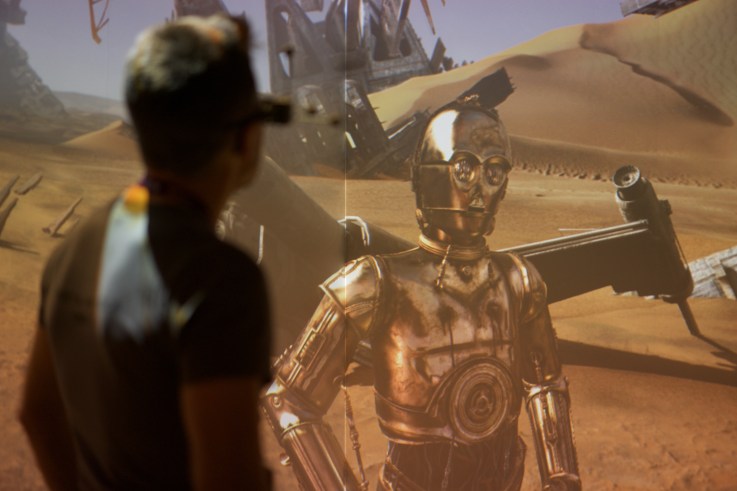
Earlier this year, LMxLAB, a research and development division for Lucasfilm and Disney, unveiled a new augmented reality installation called the Holo-Cinema at the New Frontiers program for the Sundance Film Festival.
The technology uses lightweight 3-D glasses covered in sensors, motion-tracking cameras, projectors, two screen walls, and the floor to immerse users in a cinematic world.
The Sundance exhibition featured the desert world of Jakku from Star Wars: The Force Awakens. Several different users could walk into a pre-recorded scene and explore the environment in 3D.
Cameras tracked everyone’s location so that at any given time each person’s point-of-view was specific to his/her position. The project is a signpost for the ways in which augmented reality will impact the future of the entertainment industry.
“Directors are learning their way around the medium to make content that plays better in a 360-degree environment,” Shari Frilot, New Frontiers’s Senior Programmer and Chief Curator, said in an interview with Screen Daily. “This will only keep getting better.”
John Gaeta, the executive creative director at ILMxLAB, was similarly enthusiastic about advancements in the AR field. He believes that in a few years, the technology will evolve enough to be showcased at amusement parks or even used in the privacy of your own home. The R&D lab is already working on future consumer-facing displays to accompany upcoming episodes of Star Wars.
The development of Holo-Cinema marks a major milestone in filmmaking history.
Not only does this new technology allow viewers to explore their favorite films from a new perspective, but it can also help directors determine how to film a particular scene.
Generally, filmmakers only see concept art and animation while filming, so they are unable to see computer-generated graphics combined with the actors in-scene until post-production. Holo-Cinema enables them to better visualize each scene and decide on the best camera angles and props to use.
Gaeta predicted that augmented reality would become an extension of most mainstream movies in three to five years. In five to ten years, the technology may be within the budget of even more diverse films.
Fans of Star Wars should be relieved to hear that the ILMxLAB team is working closely with Lucasfilm’s story group to provide a cohesive experience of the fictional universe. Eventually, the technology may be used to explore new worlds and subplots that are not included in the movies.
Consumers can expect to see more of the Holo-Cinema technology in other famous film series coming soon. ILMxLAB currently works with a number of filmmakers to help create more engaging theater experiences. Jurassic Park is another series that the division has been focused on this last year.
Against this backdrop, Disney has proven to be a major investor in the AR industry. Holo-Cinema is not the first example of the company’s interest in using immersive entertainment to expand the Star Wars universe. During July 2015, Disney released an official Star Wars mobile application that used AR to simulate lightsaber training.
Players must tilt their lightsabers (a.k.a. their smartphones) at different angles to block shots fired at them. This section of the app replicates the force training that Luke Skywalker underwent in the first Star Wars film.
In addition to using their phones as a lightsaber stand-in, users can interact with BB-8 or a stormtrooper in real time after scanning an image on a poster using their smartphone cameras. This free Star Wars app is available on both iOS and Android.
All of this goes to show that augmented reality is looming over the entertainment industry. By enabling viewers to engage with scenes from their favorite films, AR technology provides a captivating new experience for all theatergoers.

Comments
Post a Comment